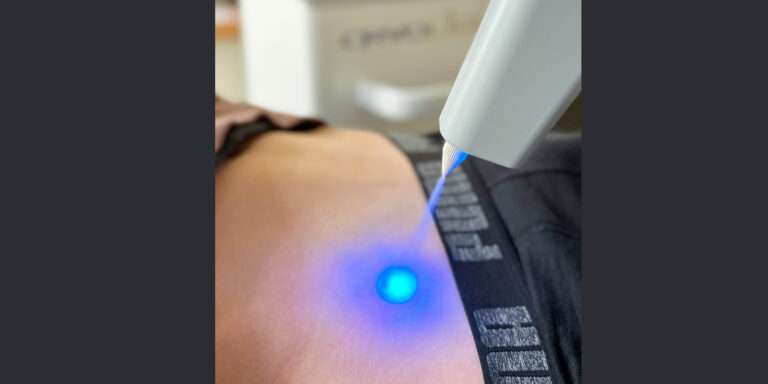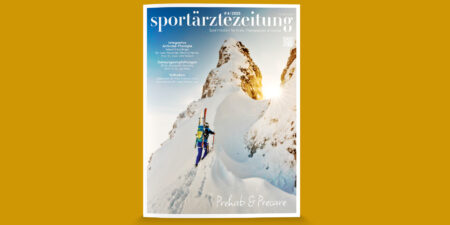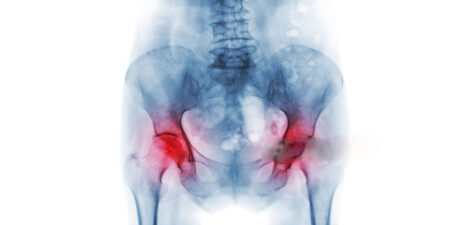Recently, and especially during and after the ‘14th Football Medical Symposium Hamburg’ on 12 October 2024 at the Volksparkstadion (organised by Prof. Dr. Götz Welsch from the UKE Hamburg and the sportärztezeitung), I have received numerous requests regarding cold and cryotherapy after my lectures as part of the ‘guided education’ series. Therefore, I was asked by the sportärztezeitung to present the topic in more detail and hopefully shed a little more light on it.
When I and many of my sports and rehabilitation medicine colleagues use cryotherapy as part of a combination therapy, we primarily mean neuroreflectory hyperbaric CO2 cryotherapy (Fig. 1). We began covering this form of cryotherapy in the sportärztezeitung as early as 2015. Even then, we reported on its use and the excellent results primarily in combination with shockwave therapy, and later also with high-power laser therapy, as part of the ‘guided education’ of the sportärztezeitung – see also the following articles:
- Superior combination therapy
- Combination therapy in practice
- Neuroreflex cold therapy
- Extremely fast regeneration with combination therapy
In this topic, we can draw on both current literature and significantly positive study results. But what is at least as important to us is our very extensive and positive practical experience with both professional athletes and our everyday patients.
Neuroreflex hyperbaric CO2 cryotherapy
In regenerative medicine, each individual form of therapy used must be thoroughly understood in order to be able to combine them boldly and thus trigger synergistic effects. This short article will focus on the special role of neuroreflex hyperbaric CO2 cryotherapy as a successful physical therapy in sports medicine. In contrast to the well-known cold therapies (with cold water, ice, cooling wraps, cold spray, cool packs and ice sponges), as we know them from all sports and play facilities around the world, this special form of therapy uses CO2 gas, which leaves the special nozzle of the handpiece at a pressure of 0.3 bar and a temperature of –78 °C to cool the affected skin area to 0 – 4°C in about 3 – 5 seconds. This extreme cold in combination with the pressure not only achieves local but also systemic vasoconstriction. The following effects arise:
- Analgesic Alleviates pain within seconds
- Antiphlogistic Restores the semi-permeability of the cell membrane and stops inflammation and oedema
formation. - Lymphatic Gas pressure + extreme cold – vasomotor effect and anti-oedema
- Neurological Reduced nerve conduction and transmission at the neuromuscular end plate, thereby relaxing the muscle fibres
An extremely fast-acting and very important effect for further regeneration is the restoration of the semi-permeability of the cell membrane and thus of the cell function, as well as the stopping of the inflammatory cascade and the associated oedema formation and pain. The additional lymphatic effect and the strong muscle-relaxing effect are helpful in many situations in practice.
A very interesting topic in connection with the effect of neuroreflectory hyperbaric CO2 cryotherapy, but one that is far from being fully understood, is the mechanism of action via TRPM8 channels (Transient Receptor Potential Melastatin 8). These play a central role in the recognition of cold environmental temperatures in the somatosensory system. TRPM8 occurs in a subgroup of non-myelinated (C-type) afferents. Its therapeutic use is currently being researched intensively.
What does experience tell us?
From my many years of experience in sports and rehabilitation medicine, I can say with conviction that I cannot imagine my individualised therapy concepts without neuroreflex hyperbaric CO2 cryotherapy (Cryolight). The effects of pain relief, decongestion, temperature regulation and muscle relaxation are impressive, lasting and reproducible in almost every case. This form of therapy is easy to use, very safe due to the device’s immediate safety shutdown function (when the temperature is colder than –2 °C for more than 2 seconds), and, above all, it takes effect very quickly. This extremely rapid effect can be the deciding factor in getting recovery started quickly in cases of acute inflammation or injury. But I would also never want to be without it again when treating chronic inflammation. In this case, it is possible to use the analgesic effect before treatment with radial or focused extracorporeal shock wave therapy (ESWT), for example, but I favour application after ESWT treatment or – ideally – high-power laser + ESWT treatment.
In this case, the analgesic effect of the laser and the prostaglandin E2 inhibition before the ESWT treatment are used to increase the treatment energy and thus the effect of the ESWT even more and to achieve a pleasant additional pain relief and muscle relaxation at the end through cryotherapy. We were also able to determine that the sometimes severe initial worsening of other therapies (ESWT, acupuncture, MBST, acupressure, …) could be significantly reduced if the neuroreflectory hyperbaric CO2 cryotherapy was applied at the end. We use it for severe local allergic reactions (e.g. after insect bites), all types of (sports) injuries, arthritis attacks, tendinopathies / enthesopathies, gout attacks, early post-operative or also for trigger point therapy for chronic or acute myogelosis. And this form of treatment is simply indispensable in our individual combination therapy concepts.
In this context, the effects and possible treatment strategies from the following articles are also very interesting and recommended for further study:
Hyperbaric Gaseous Cryotherapy: Effects on Skin Temperature and Systemic Vasoconstriction
Conclusion and outlook
In this article, we looked at one of the most promising forms of cryotherapy currently on the market. In my opinion, this type of cryotherapy is still very much underestimated and its true potential for treating the musculoskeletal system is far from being exhausted. Or why doesn’t every high-class sports club have a device like this on the sidelines? I am sure that we will be hearing and reading a lot more about this method and its possible uses in the future, as well as the therapeutic options via the TRPM8 channels mentioned. Of course, numerous members of the editorial board of the sportärztezeitung will keep you constantly up to date with practical experiences, new promising combination possibilities and also about other forms of cold therapy, such as whole-body cold therapy or also continuous cooling (see Fig. 2).

(see article Kryotherapie)
Autoren
ist Facharzt für Allgemeinmedizin und Notfallmedizin in der Praxis Allgemeinmedizin Lechhausen & MedWorks – Privatärztliche Praxis, Augsburg. Er ist ehemaliger Mannschaftsarzt des Profiteams des FC Augsburg und wiss. Beirat der sportärztezeitung.



